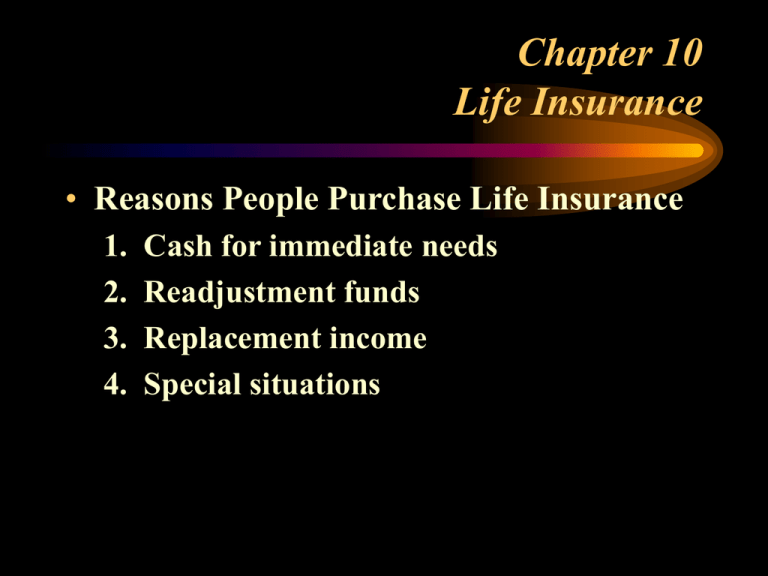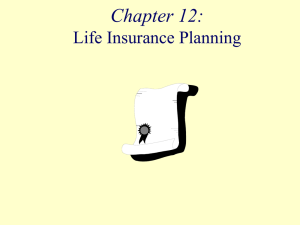Chapter 10 Life Insurance - Auburn University, College of Business
advertisement

Chapter 10 Life Insurance • Reasons People Purchase Life Insurance 1. 2. 3. 4. Cash for immediate needs Readjustment funds Replacement income Special situations Chapter 10 Life Insurance • How Much Life Insurance Do You Need? Two theories for determining life insurance needs: – Human value approach. • Attempts to forecast the value of income the person would have earned had they lived an average number of years • Inexact science at best Chapter 10 Life Insurance • How Much Life Insurance Do You Need? – Multiple earnings approach • Sufficient earnings must be available to replace earnings for certain number of years – Multiply the number of years left to replace income by factor from the multiple earnings table Chapter 10 Life Insurance • Types of Life Insurance Policies Life insurance policies can be classified into three broad categories: Term insurance Whole-life insurance Universal life insurance Chapter 10 Life Insurance • Term Insurance – “Term” is a specified period of time in the life of the insured. – It is pure insurance because it offers nothing more than financial protection if you die – Once policy expires, the insurance company has no further obligation to you – The least expensive option. For the same premium, you can purchase 5 to 10 times as much term insurance as any other type of life insurance. Chapter 10 Life Insurance • Level Term Commonly issued for periods of one year, five years, or 10 years –Offers a fixed amount of insurance coverage with premiums that are constant over length of the term –However, when term insurance is renewed, the premiums increase to reflect greater risk of dying associated with older age. Chapter 10 Life Insurance • Decreasing Term – Designed for people whose need for insurance diminishes as they get older (i.e. the mortgage is paid off, the children have finished college) – While premiums remain constant over time, insurance coverage automatically decreases as you get older Chapter 10 Life Insurance • Renewable Feature Available With Term Insurance Renewable -- gives policy holder option of renewing insurance for at least one additional period without having to pass another physical Usually additional period is same length as the original term. Many companies allow renewals an unlimited number of times until certain age, 65 or 70. Chapter 10 Life Insurance • Deposit Term Insurance – Designed to reward policyholders who keep insurance in force for a long term (time) – Has savings component as well as an insurance component so it is not true term insurance Chapter 10 Life Insurance • Deposit Term Insurance – During first year, you pay deposit as well as regular premium. Deposit placed in interest bearing account which you receive back with interest after end of term insurance. – If policy lapses before end of term, you forfeit the deposit and the interest earned Chapter 10 Life Insurance • Whole-Life Insurance Two basic differences between term and whole-life insurance: 1. Whole-life purchased for entire life whereas term is only for specified number of years 2. Savings component in whole-life which is not present in term • Allows flexibility • Increases the cost of the insurance Chapter 10 Life Insurance • Straight Life Insurance – Also termed continuous-premium whole-life or ordinary whole-life insurance – Premiums remain same throughout life of policy (determined by age and health at time of enrollment) – Premiums build cash value (accumulated savings) in the early years and help pay for the increased risk of death in later years – Majority of whole-life policies are straight life Chapter 10 Life Insurance • Borrowing From a Whole-Life Policy – Can borrow all or part of cash value in form of policy loan – Loans do not have to be paid back; Unpaid portion plus interest deducted from death benefit when paid Chapter 10 Life Insurance • Other Life Insurance Options • Group Life Insurance • Variable Life Insurance • Credit Life Insurance Chapter 10 Life Insurance • The Life Insurance Contract Contracts (legally binding you and the company) contain various type of provisions: 1. The Beneficiary Clause The beneficiary is the individual or organization who receives proceeds upon the policyholder’s death. Life insurance proceeds are NOT TAXABLE to the individual, but may be subject to estate taxes. Chapter 10 Life Insurance • 1. The Beneficiary Clause The primary beneficiary receives payment first (more than one may be named.) A contingent beneficiary should be named if primary beneficiary is no longer living. An irrevocable beneficiary cannot be changed without his consent; otherwise you can change beneficiaries as often as you wish Chapter 10 Life Insurance • The Life Insurance Contract 2. Settlement Options The settlement option specifies how death benefits will be paid: • Lump sum -- beneficiary receives entire amount at once (98% choose this method) • Life income -- beneficiary receives monthly payments for rest of life (size of payment determined by age of beneficiary) Chapter 10 Life Insurance • 2. Settlement Options, cont. – Fixed income -- beneficiary receives fixed monthly payment depending on face value of policy – Interest only -- beneficiary receives interest only paid at guaranteed rate; principal is received at a later date Chapter 10 Life Insurance • The Life Insurance Contract 3. Premium Payment Clause The policy states how much premiums are, where they are paid, to whom they are paid, and how often. annually semiannually quarterly monthly Usually small discount offered for annual premium payment. Chapter 10 Life Insurance • The Life Insurance Contract 4. The Dividend Clause This clause only applies to those policies issued by mutual life insurance companies. It may specify how dividends are paid or it may give policyholder options for payments of dividends Receiving the dividends in cash Using them to reduce premiums Using them to purchase additional life insurance Chapter 10 Life Insurance • The Life Insurance Contract 5. The Accidental Death Clause This clause guarantees an additional amount of insurance if policyholder dies as a result of an accident. Usually doubles or triples the face amount so it is referred to as double or triple indemnity. Some accidental deaths are excluded: • • • • a suicide a riot or insurrection an airplane disaster commission of a felony Chapter 10 Life Insurance • The Life Insurance Contract 6. The Suicide Clause This clause limits the company’s liability in the event of suicide. Since suicide is not accidental, if suicide occurs within two years of policy’s issue date, the company is only liable for the amount the policyholder has already paid in premiums. Chapter 10 Life Insurance • The Life Insurance Contract 7. Waiver-of-Premium Clause This clause commits the insurance company to pay your premiums if an illness or accident prevents you from working. The clause usually takes effect six months after policyholder is totally disabled. Some companies are now offering the same type of protection if you lose your job. Chapter 10 Life Insurance • The Life Insurance Contract 8. Guaranteed Insurability Clause This clause allows you to increase amounts of insurance at certain dates and by certain amounts without undergoing a physical examination. Chapter 10 Life Insurance • The Life Insurance Contract 9. Nonforfeiture Option This clause protects the cash value of your policy if your premiums are unpaid. Policyholder may choose to: Surrender the policy for cash accumulated Purchase term insurance for as long as the single premium will allow Use the cash as a single premium and purchase a reduced amount of paid-up life insurance Chapter 10 Life Insurance • The Life Insurance Contract 10. Policy Reinstatement This provision allows policyholders to put lapsed policy back into effect. Typically requires: Furnished proof of continued insurability Payment of accumulated premiums, plus interest Application for reinstatement must take place within a specified time period, usually a year






